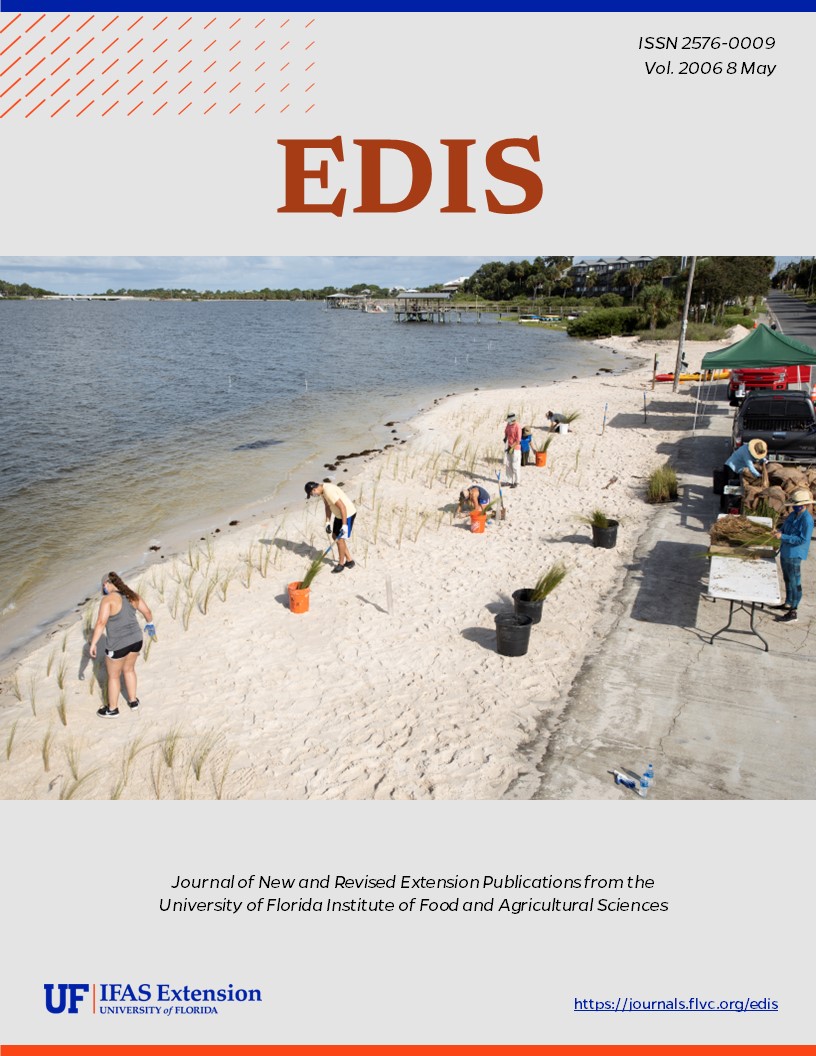Abstract
Arthropod pests limit production in the beef cattle industry by affecting animals in many ways. External parasites are the most serious threat since they feed on body tissues such as blood, skin and hair. The wounds and skin irritation produced by these parasites often result in discomfort and irritation for the animal. More significant, however, is that any blood-sucking arthropod may transmit diseases from infected animals to healthy ones. In addition, arthropod pests also may reduce weight gains, cause losses in milk and meat production, produce general weakness, cause mange and severe dermatitis, and create sites for secondary invasion of disease organisms. In general, infected livestock cannot be healthy or efficiently managed to realize optimum production levels. This document is ENY-274 (IG130), one of a series of the Department of Entomology and Nematology, UF/IFAS Extension. Original publication date May 1995. Revised March 2006.
References
Broce, A. B. 1988. An improved Alsynite trap for stable flies Stomoxys calcitrans (Diptera: Muscidae). J. Med. Entomol. 25: 406-409. https://doi.org/10.1093/jmedent/25.5.406
Catts, E. P and G. R. Mullen. 2002. Myiasis (Muscoidea, Oestroidea), In: Medical and Veterinary Entomology, (G. R. Mullen and L. A. Durden, Eds.), pp. 318-348. Elsevier Science, San Diego, CA. https://doi.org/10.1016/B978-012510451-7/50018-9
Geden, C. J. and D. A. Rutz. 1988. Cattle lice are more than a winter problem. St Lawrence Cty Coop Ext News 72: 7, ill.
George, J. E., R. B. Davey and J. M. Pound. 2002. Introduced ticks and tick-borne diseases: the threat and approaches to eradication. Vet. Clin. Food Anim. 18: 401-416. https://doi.org/10.1016/S0749-0720(02)00030-0
Hogsette, J. A., and J. P. Ruff. 1985. Stable fly (Diptera: Muscidae) migration in Northwest Florida. Environ. Entomol. 14: 170-175. https://doi.org/10.1093/ee/14.2.170
Holste, J. E., D. D. Colwell, R. Kumar, J. E. Lloyd, N. P. M. Pinkall, M. A. Sierra, J. W. Waggoner, W. K. Langholff, R. A. Barrick and J. S. Eagleson. 1998. Efficacy of eprinomectin against Hypoderma spp. in cattle. Am. J. Ver. Res. 59: 56-58.
Jones, C. J., J. A. Hogsette, R. S. Patterson, D. E. Milne, G. D. Propp, J. F. Milio, L. G. Rickard and J. P. Ruff. 1991. Origin of stable flies (Diptera: Muscidae) on West Florida beaches: Electrophoretic analysis of dispersal. J. Med. Entomol. 28: 787-795. https://doi.org/10.1093/jmedent/28.6.787
Klein, K. K. and F. P. Jetter. 1987. Economic benefits from the Alberta warble control program. Can. J. Agric. Econ. 35: 289-303. https://doi.org/10.1111/j.1744-7976.1987.tb02230.x
Matthysse, J. G. 1946. Cattle lice: Their biology and control, pp. 1-67. Cornell University Agricultural Experiment Station, Ithaca, NY.
Moon, R. D. 2002. Muscoid flies (Muscidae), In: Medical and Veterinary Entomology, (G. R. Mullen and L. A. Durden, Eds.), pp. 45-65. Elsevier Science, San Diego, CA. https://doi.org/10.1016/B978-012510451-7/50016-5
Mullens, B. A., A. C. Gerry and R. K. Velten. 2001. Failure of a permethrin treatment regime to protect cattle against Bluetongue Virus. J. Med. Entomol. 38: 760-762. https://doi.org/10.1603/0022-2585-38.5.760
Nelson W. A., J. E. Keirans, J. F. Bell and C. M. Clifford. 1975. Review article host-ectoparasite relationships. J. Med. Entomol. 12:143-166. https://doi.org/10.1093/jmedent/12.2.143
Pickens, L. G., E. T. Schmidtmann and R. W. Miller. 1994. How to control house and stable flies without using pesticides, pp. 1-14. USDA, Washington, DC.
Rochon, K., T. J. Lysyk and L. B. Selinger. 2004. Persistence of Escherichia coli in immature house fly and stable fly (Diptera: Muscidae) in relation to larval growth and survival. J. Med. Entomol. 41: 1082-1089. https://doi.org/10.1603/0022-2585-41.6.1082
Scholl, P. J. 1993. Biology and control of cattle grubs. Annu. Rev. Entomol. 39:53-70. https://doi.org/10.1146/annurev.en.38.010193.000413
Skoda, S. R., J. B. Campbell and S. E. Kunz. 1987. Wide-area treatment of cattle for horn flies and face flies (Diptera: Muscidae) in South-central Nebraska. J. Econ. Entomol. 80: 811-816. https://doi.org/10.1093/jee/80.4.811
Steelman, C. D., R. W. McNew, R. B. Simpson, R. W. Rorie, J. M. Phillips and C. F. Rosenkrans Jr. 2003. Evaluation of alternative tactics for management of insecticide-resistant horn flies (Diptera: Muscidae). J. Econ. Entomol. 96: 892-901. https://doi.org/10.1093/jee/96.3.892
Suarez, V. H., A. L. Lifschitz, J. M. Sallovitz and C. E. Lanusse. 2003. Effects of invermectin and doramectin faecal residues on the invertebrate colonization of cattle dung. J. Appl. Entomol. 127: 481-488. https://doi.org/10.1046/j.0931-2048.2003.00780.x
Tarry, D. W. 1985. Cattle fly control using controlled-release insecticides. Vet. Parasit. 18: 229-234. https://doi.org/10.1016/0304-4017(85)90048-2
Watson, D. W., J. D. Lloyd and R. Kumar. 1997. Density and distribution of cattle lice (Phthiraptera: Haematopinidae, Linognathidae, Trichodectidae) on six steers. Vet. Parasit. 69: 283-296. https://doi.org/10.1016/S0304-4017(96)01122-3
Watson D. W., S. M. Stringham, S. S. Dennings, S. P. Washburn, M. H. Poore and A. Meier. 2002. Managing the horn fly (Diptera: Muscidae) using an electric walk-through fly trap. J. Econ. Entomol. 95: 1113-1118. https://doi.org/10.1093/jee/95.5.1113
Wright, R. E. 1985. Arthropod pests of beef cattle on pastures and range land In: Livestock Entomology (R. E. Williams, R. D. Hall, A. B. Broce and P. J. Scholl, eds.), pp. 191-206. Wiley, New York.

